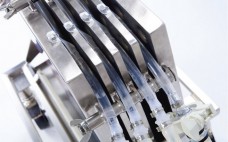Downstream protein purification (the stage in which a protein is isolated and purified) is one of the last steps in biotherapeutic manufacturing. Single-use technologies are an increasingly popular choice for both upstream and downstream bioprocessing because they offer significant benefits over traditional multiuse manufacturing systems. Single-use technologies also provide an array of logistical benefits, including reduced costs, minimized risk of cross-contamination, and improved operational efficiency (1). Challenges remain, however, in designing a complete, streamlined, single-use process for downstream protein purification.…
Downstream Single-Use Technologies
Industry Adoption of Membrane Adsorbers
Membrane adsorbers (MAs) are the fastest-growing segment in single-use bioprocessing. But their future is not entirely certain. According to BioPlan Associates’ latest survey of biopharmaceutical manufacturing, the MA market has been growing at ~20% annually since 2006 (1). Paradoxically, however, the segment may not be a true “rising star.” Our study also shows that MAs remain among the least-often adopted devices among biomanufacturers. So the question of how and whether MA technology can revolutionize bioprocessing remains open. Market for Membrane…
A CMO Perspective on Quality Challenges for Biopharmaceuticals
The global annual revenue for biopharmaceuticals has been growing consistently since 2001, accounting for 15.6% of the total pharmaceutical market in 2011. The global biopharmaceutical market was valued at US$138 billion in 2011 and is expected to surpass $320 billion by 2020 (1). The market for recombinant proteins now exceeds $100 billion, a milestone attained in 2011. Figure 1:  () Much of the growth in biopharmaceutical revenue is due to an increasing number and sales of recombinant…
An Emerging Answer to the Downstream Bottleneck
Biotechnology companies have invested billions of US dollars in new manufacturing infrastructure, expanding the industry’s total mammalian cell culture production capacity from 670,000 L in 2002 to 2,550,000 L in 2010 (Figure 1) (1). This capacity expansion is estimated to have cost the industry about $20 billion (Figure 2) (1). Figure 1: Macroporous structure of Natrix chromatography media (see () Figure 1: () Figure 2: () That production capacity (and the investment it represents) is…
Large-Scale, Single-Use Depth Filtration Systems
Clarifying cell culture broth is the first downstream unit operation in an elaborate sequence of steps required to purify a biological therapeutic. A combination of centrifugation, depth filtration, or tangential-flow filtration (TFF) is used for that operation. The availability of largescale, single-use, depth filtration technology in the recent years, however, has given process developers the capability to improve and simplify downstream processes. Clarification of Cell Culture Streams The main purpose of clarification is to efficiently separate…
Use of Blast Freezers in Vaccine Manufacture
Vaccines are powerful and cost effective prophylactic tools for protecting public health. The Global Alliance for Vaccines and Immunizations (GAVI) estimates that ~5.4 million lives are saved each year by the administration of vaccines for hepatitis B, measles, haemophilus influenza type B (hib), pertussis (whooping cough), yellow fever, and polio (1). According to the World Health Organization, seasonal influenza alone claims 250,000–500,000 lives every year globally, many of which could be prevented by more widespread vaccination with the…
A Case Study in Qualification of Single-Use Filling Manifolds for Particles and Endotoxins
Single-use technology is being examined for implementation in an increasing number of steps in the biopharmaceutical manufacturing process. Some examples of currently available disposable components include filter capsules, tubing, connectors, and biocontainers (for storage, mixing, and bioreactors), as well as devices for chromatography and multipass tangential-flow filtration (1,2). This technology was first implemented in upstream and API downstream processes such as media and buffer preparation, followed by upstream bioreactors and mixers (3). The single-use trend has most recently…
Implementing a Single-Use Solution for Fill–Finish Manufacturing Operations
Fill–finish is the final operation in manufacture of sterile products (except for terminally sterilized products). This process requires sophisticated technology and machinery in a highly controlled, aseptic environment. Fill–finish assemblies must meet stringent requirements to ensure flow-path sterility and integrity, ensure operational safety and efficiency, and provide fill-volume accuracy to exacting requirements. Traditional fill–finish machinery comes as fixed systems comprising complex components that require assembly, cleaning and sterilization, disassembly, and material storage after filling is complete. Those operational…
Disposable Downstream Processing for Clinical Manufacturing
Although disposable parts and modules have been used in the biopharmaceutical industry since the 1970s, as detailed in the “History” box, total disposable manufacturing has become a viable option only very recently. Whereas liquid storage became disposable in the 1990s, processing operations such as depth filtration, tangential-flow filtration (TFF), and chromatography have still required skids with reusable flow paths that needed cleaning and sanitization. Important recent milestones in total disposable technology included introduction of stirred bioreactors by HyClone (Thermo Scientific)…
Improved Downstream Technologies Are Needed to Boost Single-Use Adoption
Greater adoption of single-use systems in biomanufacturing is going to require downstream device innovation. To get there, over a third of the biopharmaceutical industry is demanding that suppliers innovate and develop new single-use purification devices, according to BioPlan Associates, Inc.’s annual survey of biopharmaceutical manufacturing capacity (1). Such new products would create exceptional opportunities for innovators. However, calls for new, more fully integrated single-use technologies and processes will require more adventurous innovation on the part of biomanufacturers and their suppliers.…

